Becky Shindell Recent Google Changes: SEO Tactics that Move the Needle in 2017 #semrushchat 98 Wow-Score The Wow-Score shows how engaging a blog post is. It is calculated based on the correlation between users’ active reading time, their scrolling speed and the article’s length. Learn more Recent Google Changes: SEO Tactics that Move the Needle in 2017 #semrushchat
- 216
- 56
- 13
- 52
- 1
Google has a long history of its algorithm updates and search index refreshes. The search engine is constantly changing its algorithms in order to provide its users with the best possible search experience. During our latest SEMrush Chat, we discussed recent changes in Google search and how to adjust your SEO strategy accordingly. We were very excited to have Matthew Capala, the founder of SEO agency, Alphametic, author of "SEO Like I'm 5," workshop trainer, and speaker, as our special guest.
Check out the following chat recap to learn how to succeed in mobile search, win the local search battle, and which tools to use to improve your website’s performance.
Q1. How has Google SERP changed recently? Which updates have had the most impact?
Google is always a zero-sum game. When someone is winning, others are losing. Everybody knows that Google sometimes experiments with its SERPs, changing the result page layout. Here are five things that have had the most impact on websites’ performance:
1. “Possum” update
Our special guest named several key changes in the SERP layout like featured snippets, direct answers, PageRank Zero, Twitter feed, Accelerated Mobile Pages (AMP), new ad formats and mobile snippets. Also, Matthew Capala pointed out that the “Possum” algorithm update had the biggest impact on Google’s SERP, as it changed 64 percent of local SEO listings.
Possum is a name that was suggested by Phil Rozek. This massive local algorithm update happened in September of 2016 and made it so local search results are dependent on the searcher’s location and it uses a proximity test whether or not the company qualifies to rank.
Matthew Capala @SearchDecoder
A1: (2/2) A series of #Google updates since Hummingbird… Possum had biggest impact on SERP, changed 64% of local #SEO listings #SEMRushChat
— Matthew Capala (@SearchDecoder) March 8, 2017
To learn more about Possum, you can check out Joy Hawkins’ post about this local algorithm update on Search Engine Land.
A1: Localization has been a big change to SEO lately. #semrushchat
— Netvantage Marketing (@netvantage) March 8, 2017
2. Related questions
As you may know, Google can display an expanding grid box within the search results themselves for some queries. These boxes contain a series of questions that include the search term you’re looking for. If you click one of these questions, it will expand to show a brief potential answer to your query and a link.
Some website owners spend their effort and time to show up in related questions. They’re doing this to try to build their site authority by being one of those chosen by Google to provide answers to the searcher’s question.
A1 "People also Asked" for results are supposed to show off unasked topics related to a query of yours #SEMRushChat
— Bill Slawski (@bill_slawski) March 8, 2017
3. Ad layout changes
Expanding text ads and removing the ads from the right rail of the Google SERPs bewildered both SEO specialists and paid search marketers. Some experts noticed that these changes make organic search engine rankings even more competitive. “The change to the SERP page overall is the biggest difference, though. Ads pushing organic listings down now,” tweeted Reva Minkoff @revaminkoff.
Highly competitive terms are becoming more competitive than ever. As a result, SEO specialists need to look for new opportunities in the long-tail keywords for less competition.
A1: Ad display changes (expansion of stack, removal or right-hand block). Makes organic rank even more important/competitive. #semrushchat
— Jason Barbato (@Digital_JB) March 8, 2017
4. Rich snippets and structured data
Over the years, rich snippets have evolved. Google added various types of snippets to provide more informative and eye-catching options, rather than regular search results. In 2011, Schema.org was introduced by Google, Bing and Yahoo! to support a set of schemas for structured data markup on web pages. This initiative was intended to make it easier for webmasters to improve their search results and get the maximum benefits from their efforts. When information is highly structured and predictable, it’s easier for search engines to organize and show it in a more creative way.
All these updates changed the way people see search results pages and made digital marketers develop their search campaigns accordingly.
A1. Rich snippets and structured data have made a big difference in the results – people reading info without clicking. #semrushchat
— Reva Minkoff (@revaminkoff) March 8, 2017
“Structured Data (may become a signal) Mobile Update, Real-Time Penguin Update. To name a few. Same old SEO with a new spin,” pointed out Gabriella Sannino @SEOcopy.
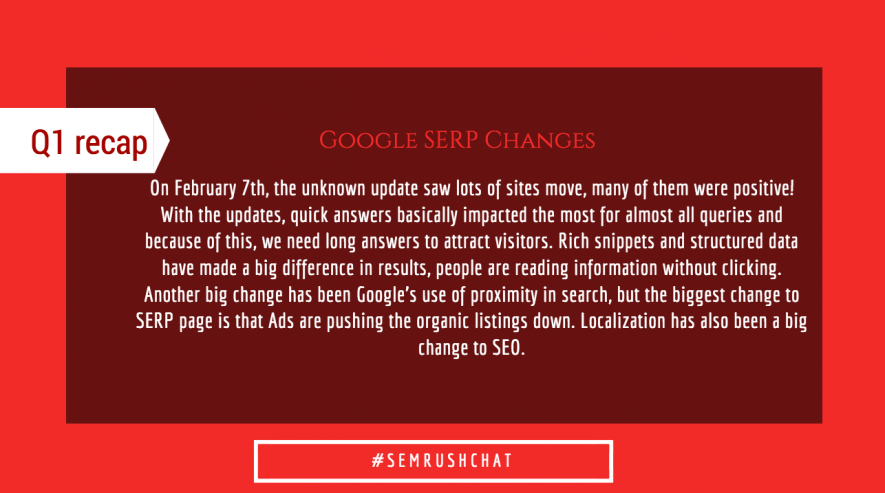
Which Google’s SERP changes have had the most significant impact on your digital marketing strategies? Let us know in the comments. We would love to hear about your experience!
Q2. Is it harder to rank on mobile than on desktop? If yes, why and how to succeed?
As more people use their smartphones and tablets to search for what they need on the Internet, the way companies find and attract new customers continues to evolve through mobile search. However, tactics you use for traditional desktop SEO will not work the same way for mobile search optimization.
Matthew Capala believes that it’s easier to rank on mobile, because many sites are still not optimized for mobile search:
A2: It's actually easier to rank on mobile bc/ so many sites are not mobile optimized, but your mobile #SEO needs to rock (1/2) #SEMRushChat https://t.co/Obr9UekEmI
— Matthew Capala (@SearchDecoder) March 8, 2017
To succeed in mobile search, Matthew recommends focusing on your site speed, user friendliness, AMP, and technical aspect.
A2: (2/2) Focus on speed, UX, AMP, rich snippets, technical, remove popups… Mobile speed & UX crucial m. SEO ranking factors #SEMRushChat
— Matthew Capala (@SearchDecoder) March 8, 2017
Most of our chat guests agreed that user experience (UX) is one of the most important ranking factors of mobile SEO. Google aims to provide a great experience on any device, ensuring that the search results it delivers reflect this principle. As the search engine is switching to a mobile-first index, the mobile version of your site count for ranking purposes. Therefore, you need to make sure that your site is mobile-friendly.
A2: User experience is key for ranking on mobile. If you're not taking your mobile experience, seriously, then yes, harder. #semrushchat
— Maureen Jann (@MaureenOnPoint) March 8, 2017
To provide a great smooth experience, you need to decrease your mobile website’s loading time. Your site visitors will thank you if they can access your site more easily and faster. It’s important to ensure that your image sizes aren’t too large. You can keep your image files small by specifying the width and height dimensions in your HTML image tags, compressing and resizing your images.
A2 Ranking might not be the biggest issue, if you focus on speed and UX on mobile, getting the CTR…we'll that's different. #semrushchat
— Arnout Hellemans (@hellemans) March 8, 2017
Another difference between desktop and mobile search is that a mobile user’s search intentions may vary from desktop user’s intentions, even if both of them conduct the same search. For example, a person who’s searching for a pizza on a mobile device may be looking for an address or a phone to visit the place or reserve a table. At the same time, a desktop user who’s also searching for a pizza may want to find a pizza delivery option.
A2. Ppl looking for answers on mobile are more impatient than who are searching on desktop. Intent of search important here. #semrushchat
— Praveen Sharma 🇮🇳 (@i_praveensharma) March 8, 2017
Dawn Anderson pointed out that more than a half of mobile searches have a local intent. For queries with local intent (e.g., “Italian restaurant,” “coffee shop,” etc.), Google wants to show its users results that are located near the mobile user. If your business is location-based, you should set up your company properly for local search.
A2) Plus also 56% of searches on mobile have local / location intent – heard it at #WSDM2017 – so make pages relevant for that #semrushchat
— Dawn A ໒( ⁰ _ʖ ⁰ )७ (@dawnieando) March 8, 2017
Finally, Marianne Sweeny @msweeny emphasized the importance of optimizing your website for what your visitors are looking for and where they are doing it: “Don't think device.Think user, where are they? What are they looking for from there? Optimize for that to win.”
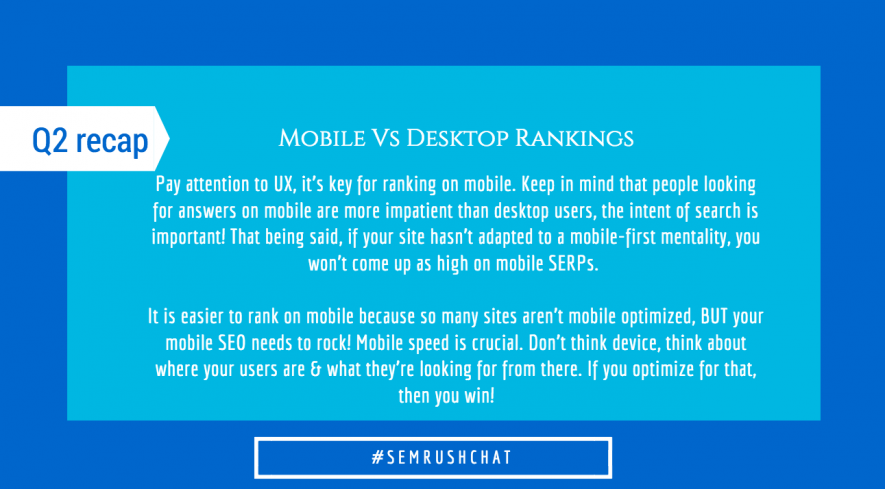
As you can see, most of our chat participants said that you need to make sure you have a mobile-friendly site. Otherwise, it will be much more difficult to rank in Google.
Q3. How can a local business win the search battle? Any SEO and PPC tactics they could use with limited budgets?
It’s more important than ever to help your customers easily find your business online through local SEO. Here are eight tactics that can help businesses with a limited budget to win the local battle:
1. Reviews and citations
Local citations and business reviews are vital for any local company. Citations from well-established and well-indexed portals help search engines confirm information they have about your business, such as categorization and contact information. When it comes to consumers, people tend to better engage with a local business that has attracted positive citations and reviews from other like-minded clients.
2. “Near me” keywords
Mobile users who search for online businesses on the go want information fast. When they come calling, you need to be there with the information at the right time.
Google uses “near me” searches to return specific results that are close to a searcher. With the queries, the search engine can provide the searcher with the most relevant results by taking into account the location the user is searching from.
It may be worth capitalizing on the “near me” local query trend.
A3: Win local visibility w/ reviews, citations, data accuracy, 'near-me' kws, mobile, location-specific content, local PR/links #SEMRushChat https://t.co/mLCjDjn1Pb
— Matthew Capala (@SearchDecoder) March 8, 2017
3. Schema markup
You can boost your SEO efforts by utilizing the Schema.org markup. By adding the structured markup to your website, you’re actually helping the search engines to better identify content on your website, such as your company’s name, address, and phone number. Using your Schema markup, the search engines can easily discover that information. You can check out a list of Schema markup elements for local SEO that you’re likely want to use on your site.
A3. Use location based keywords with your meta tags. Schema markups can help. And geo tags. #semrushchat
— Sayan Sarkar (@SayanTheGeek) March 8, 2017
4. Hyperlocal advertising
Hyperlocal advertising is a way to promote your local business to a very targeted audience based on their specific location, which is usually pinpointed with the help of navigation technologies, such as GPS on smartphones. Generally, local companies have limited budgets, as opposed to the bigger market players. Therefore, they need to carefully develop their advertising campaigns in order to spend money more strategically. Hyperlocal advertising can be a powerful tool to get those businesses in front of their local relevant audience.
A3: (2/2) Hyperlocal advertising is on the rise in 2017, test the new Google local ad formats for more local visibility #SEMRushChat pic.twitter.com/bprItLqC3x
— Matthew Capala (@SearchDecoder) March 8, 2017
5. Google My Business listing
Using Google My Business listings can help you improve your business’s local ranking. For local businesses, having a great GMB listing means higher chances of getting your business show up on the first page above the organic search results. Once you’ve created a GMB profile, you can fill out as much information as possible and upload photos that can help you tell a better story about your business.
A3: Keep your site focused on your location. Follow best practices and ensure you complete your local / my business listing #semrushchat
— Andy Drinkwater (@iqseo) March 8, 2017
6. AdWords Express
Google AdWords Express is an advertising product that was introduced by Google in 2011. If you need your advertising campaigns up and running as quickly as possible with limited resources, AdWords Express can be a good option. It automatically manages your online ads, eliminating the need for daily management and tasks. The product is especially good for small and medium-sized business that usually have limited financial and human resources.
A3: AdWords Express is a great option. Big fan of Moz Local for consistent data. Schema your business NAP. #semrushchat
— Dario Zadro (@DarioZadro) March 8, 2017
7. Localization
If you have a local business, local PPC campaigns can be worth your time and effort. Users often begin their queries with local modified search first. Building local terms in your campaign is a great way to gain additional qualified traffic and test some out-of-the-box solutions.
A3) International localization is key w/PPC. Always Test (Change to a limited match when in doubt) Re-marketing is ur friend. #semrushchat
— Gabriella Sannino (@SEOcopy) March 8, 2017
8. Mutual support between local businesses
Finally, Bill Slawski made a great point, saying that small local businesses need to join their forces and work together in order to compete with their larger counterparts. There’s no point to look at each other as competitors, but only as partners. If you’re a small business, you can try to build collaborative relationships with other small companies. As a small company, you can join virtual communities for startups, share resources with your partners, support each other, and hold promotional events together.
Local business should join forces, share resources, hold promotional events together; support each other; unity means victory. #SEMRushChat https://t.co/UujKdjvct4
— Bill Slawski (@bill_slawski) March 8, 2017
Let’s sum up!
If you are a small local business you can test these tactics our chat participants shared to win the search battle.
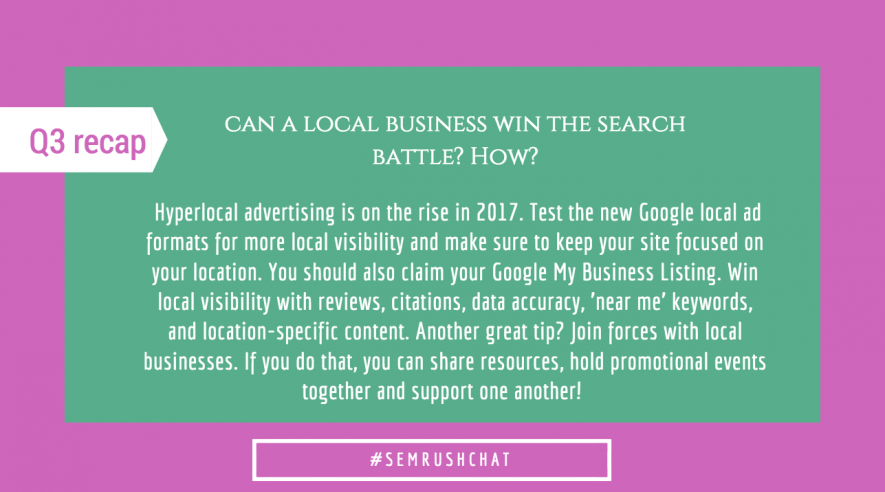
Q4. Google says that links, content and AI are top ranking factors. Which made the biggest difference in your rankings?
According to Google, the top three ranking signals in its algorithm are links, content, and RankBrain. We asked our chat participants to say which of them made the most significant difference in their rankings.
Here’s what they answered.
Matthew Capala believes that backlinks remain the decisive SEO factor, having strong correlation with rankings. Backlinko’s conducted a research, analyzing 1 million Google search results. The findings of the study showed that backlinks remain a very important ranking factor. Matthew also pointed out that high-quality content and RankBrain can help you get in the game. With RankBrain, we may assume your SEO campaign will need to be more adaptable to changes in the search ranking landscape.
A4: (1/2) Quality content and RankBrain can get you in the game, backlinks will tip the scale #SEMRushChat pic.twitter.com/ZsidCID22I
— Matthew Capala (@SearchDecoder) March 8, 2017
Some of our chat participants pointed out that quality, relevant, and useful content is the key part of a good SEO strategy.
Matthew Young @MatthewAYoung
A4. Content has had a pretty significant impact on performance for me. Without the content, you have no links. #semrushchat
— Matthew Young (@MatthewAYoung) March 8, 2017
Andy Drinkwater said that great content can help you attract links and quality traffic and improve your Google SERPs.
A4: Content is where starts. Write amazing content and this can attract links, traffic and higher SERPs #semrushchat
— Andy Drinkwater (@iqseo) March 8, 2017
Maureen Jann recommended providing your users with clear answers to their questions in order improve your content. “Good content, then the links follow!” tweeted Alison Foxall @alisonmf.
A4: Useful content is at the core of our SEO strategy, so when we started explicitly answering user questions, we improved. #semrushchat
— Maureen Jann (@MaureenOnPoint) March 8, 2017
Patrick Stox also shared his experience, saying that he ranked his web pages even without links and content. Based on this experience, he advised that having both of these elements is crucial.
A4: I've ranked pages without links. I've ranked pages without content. I'm going to say you should probably have both. #semrushchat
— Patrick Stox (@patrickstox) March 8, 2017
Let’s sum up with this David Rosam @writingforseo “Great links. Fantastic Content. Wonderful site structure. Oh, and lighting a joss stick and repeating my Google mantra,” David Rosam @writingforseo.
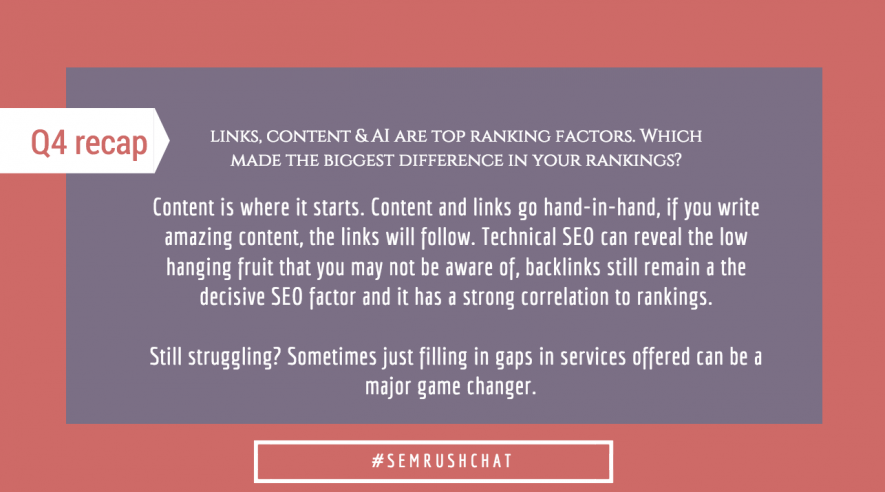
What are your thoughts on these three factors and their impact on your search rankings? Don’t hesitate to share them in the comments!
Q5. The perfect SEO toolkit: If budget was not an issue, which SEO tools/software would you get to improve your performance?
At the end of our discussion, our chat guests shared SEO tools that can help you improve your website’s performance. Besides well-known, highly useful services, they named there were several different tools that you probably haven’t tested yet:
-
Linkdex. Linkdex is an SEO platform for marketers who are looking for ways to boost their optimization and outreach strategies. This tool brings together several digital marketing areas; SEO, PR, content, and Social Media to help digital marketers plan more strategic campaigns.
A5 Paid/Premium #SEO Toolbox: SEMRush, Moz Pro, Ahrefs, Ravens Tools, Searchmetrics, BuzzSumo, cognitiveSEO, Conductor, Linkdex #SEMRushChat https://t.co/7Rc7VxBDJU
— Matthew Capala (@SearchDecoder) March 8, 2017
A5: SEMrush, Ahrefs, Screaming Frog, Conductor, Buzzsumo, WordStream, Google, Buzz Stream to name a few #semrushchat
— Danny Ray Lima (@dannyraylima) March 8, 2017
-
URL Profiler. This SEO tools was designed to quickly audit links, content, and social data. The service can help you with a range of tasks you do everyday, such as classifying links and removing penalties, collecting social and contact data or getting insight into your content.
A5 @getSTAT #semrushchat https://t.co/2PqgrR4SWU
— Gyi 🗽🦅 (@gyitsakalakis) March 8, 2017
-
OnPage.org. OnPage.org is a service that focuses on the substantial on-site SEO analysis. The tool helps identify your potential website bugs and errors., improving your visibility in search engines.
A5) Some of my current tools. @semrush , @OnPage_org , @DeepCrawl , @sistrix @screamingfrog, Search Console @googlewmc #semrushchat
— Dawn A ໒( ⁰ _ʖ ⁰ )७ (@dawnieando) March 8, 2017
-
PRO Sitemap. This sitemap generator is easy to use offers some additional SEO tools, such as XML sitemap validator, keyword density calculator, and a SERP page checker.
A5) And hosted sitemaps is totally the most powerful tool for SEO ever on larger sites -> https://t.co/iqq6TQBsCJ #semrushchat
— Dawn A ໒( ⁰ _ʖ ⁰ )७ (@dawnieando) March 8, 2017
Whitespark. Whitespark build tools and provides services for businesses with local search marketing. Its tools help you find local citations, build your reputation via customer testimonials, and prospect quality links for you.
A5. @ahrefs , @whitespark , @semrush #semrushchat
— Sayan Sarkar (@SayanTheGeek) March 8, 2017
We were happy to know that our chat guests would recommend SEMrush to improve your online performance.
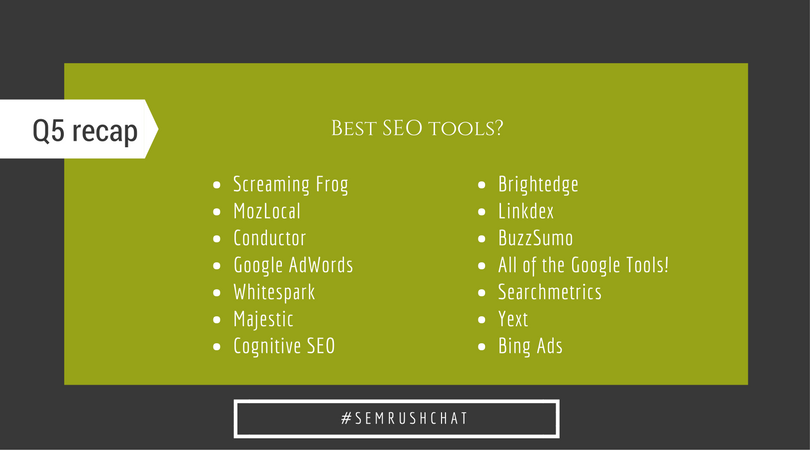
Don’t forget to check out a few other services that our chat participants mentioned in the following recap!
Huge thanks to Matthew Capala and out other chat participants for sharing their experience and expertise! Hopefully, their tips will help you plan your 2017 SEO campaign more strategically.
Make sure to check your site’s volatility with the SEMrush Sensor Tool! You can also put your knowledge to the test with our SEMrush Sensor Madness Bracket!

.



